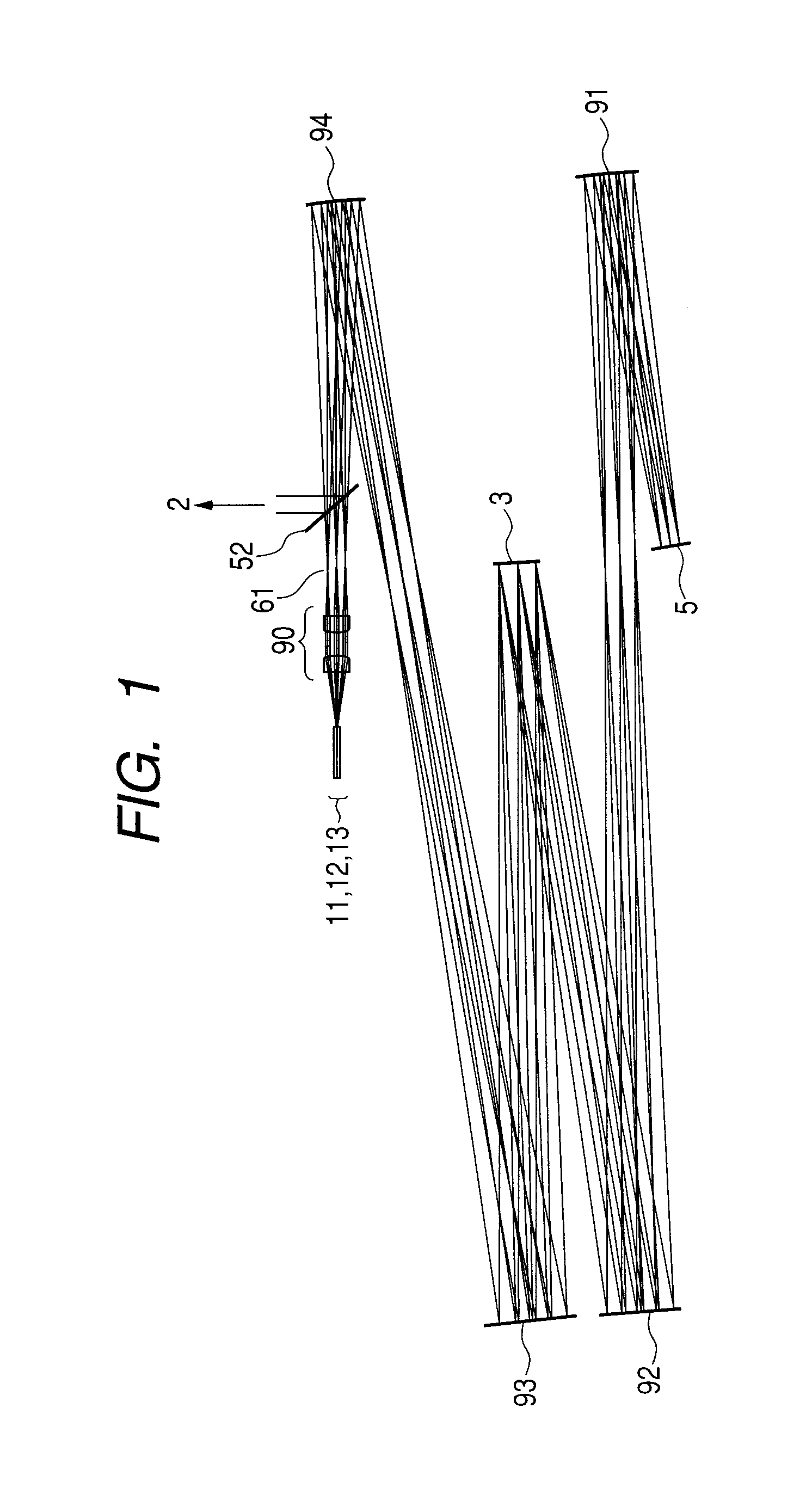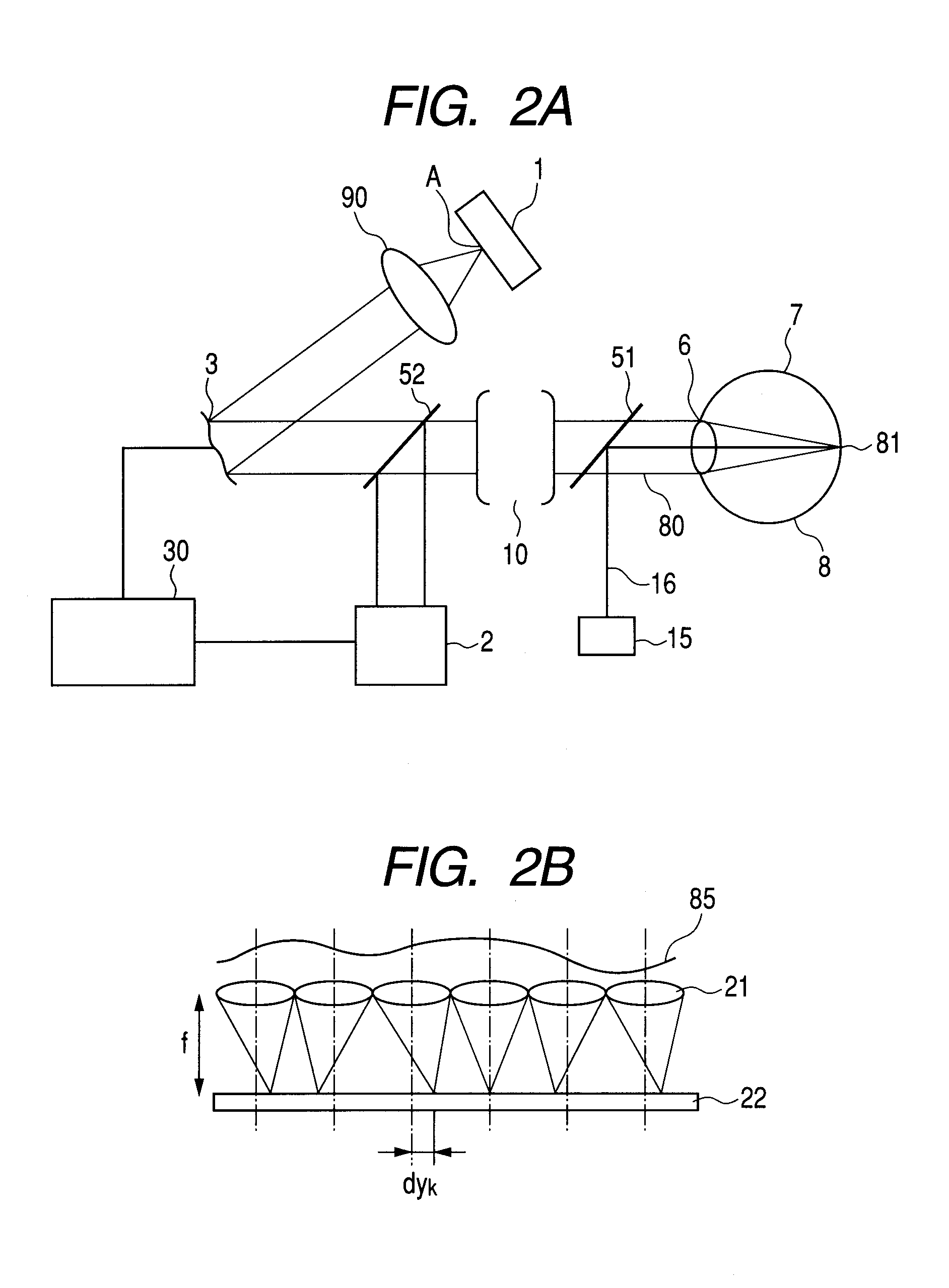Image acquisition apparatus including adaptive optics
an image acquisition and optics technology, applied in the field of image acquisition apparatus including adaptive optics, can solve the problems of reducing the time of image acquisition, limiting the energy that can be irradiated to prevent the damage of the retina of the eye, and unable to realize the increase of the light beam, etc., to achieve the effect of high definition of images
- Summary
- Abstract
- Description
- Claims
- Application Information
AI Technical Summary
Benefits of technology
Problems solved by technology
Method used
Image
Examples
example 1
[0132]A main part of an image acquisition apparatus including an adaptive optics in Example 1 to which the present invention is applied is described using FIG. 1.
[0133]In FIG. 1, a wavefront aberration correcting device (DM) 3 and a beam emission ends 11, 12, and 13, which correspond to the fiber end A described in FIG. 2A, are provided.
[0134]A deflector 5, an exit pupil 61 of a collimator optical system, a collimator optical system 90, and aspherical mirrors aspherical mirror 91, 92, 93 and 94 are provided.
[0135]Light from a low-coherent light source for such as one of an SLO and an OCT propagates through three optical fibers. The light is emitted as divergent beams respectively from the emission ends 11, 12, and 13 arranged at a distance of 1 mm from one another in a decentered section (a paper surface) and collimated by the collimator optical system 90. A beam diameter (relative intensity 1 / e2) at this point is φ7.4 mm.
[0136]collimated three beams pass through the exit pupil 61. ...
example 2
[0151]Example 1 is an example in which the three beam emission ends are arranged in the decentered section (the yz surface). However, it is possible to simultaneously scan a larger number of beams and increase speed of image acquisition by arranging an emission end in the x axis direction as well.
[0152]Design data of an optical system in which nine (3×3) emission ends are arranged in a lattice shape on an xy surface is shown in Table 4. An angle of view x in a pupil is set to ±3 degrees in both x and y direction sections, a pupil diameter is set to φ6.7 mm, and wavelength is set to 840 nm. Wavefront aberrations of beams are illustrated in FIGS. 8A, 8B, 8C, 8D, 8E, and 8F. However, since the wavefront aberrations of the left line and the right line of FIG. 8G are symmetrical, characteristics of F3, F6, and F9 among angle of view positions illustrated in FIG. 8G are omitted. All the wavefront aberrations are around 0.9 in a Strehl ratio.
TABLE 4Surface NumberRadius of CurvatureSurface ...
example 3
[0153]In Example 3, a configuration example in which the adaptive optics of the present invention described above is applied to an OCT capable of acquiring a three-dimensional tomographic image is described with reference to FIG. 9.
[0154]Light from a low-coherent light source 100 propagates through an optical fiber and is split at a predetermined ratio in a fiber coupler, then emitted as divergent beams respectively from the emission ends 11,12 and 13, and collimated by the collimator optical system 90.
[0155]Collimated three beams pass through the exit pupil 61. After passing through the exit pupil 61, the beams are made incident on the DM 3, which is a surface optically conjugate with the exit pupil 61 and the pupil 6 of the eye to be inspected, in a state of collimated beams at different angles by the aspherical mirrors 94 and 93 and superimposed on the DM 3 surface.
[0156]The diameter of the beams at this point is φ10 mm, which is slightly smaller than an effective diameter of the...
PUM
 Login to View More
Login to View More Abstract
Description
Claims
Application Information
 Login to View More
Login to View More - R&D
- Intellectual Property
- Life Sciences
- Materials
- Tech Scout
- Unparalleled Data Quality
- Higher Quality Content
- 60% Fewer Hallucinations
Browse by: Latest US Patents, China's latest patents, Technical Efficacy Thesaurus, Application Domain, Technology Topic, Popular Technical Reports.
© 2025 PatSnap. All rights reserved.Legal|Privacy policy|Modern Slavery Act Transparency Statement|Sitemap|About US| Contact US: help@patsnap.com



